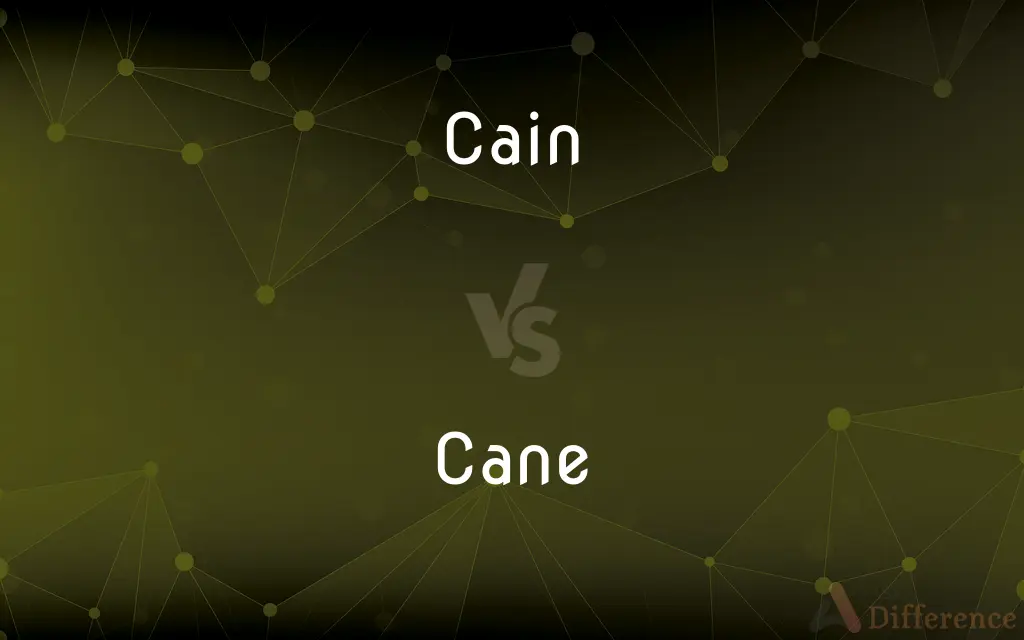Cain vs. Cane — What's the Difference?
By Maham Liaqat & Urooj Arif — Updated on March 17, 2024
Cain refers to a biblical figure known for committing the first murder, while cane signifies a stick used for support, or a material derived from sugar or bamboo plants.

Difference Between Cain and Cane
Table of Contents
ADVERTISEMENT
Key Differences
Cain is a character from the Book of Genesis in the Bible, notably recognized as Adam and Eve's first son who became the first murderer by killing his brother Abel. This story emphasizes themes of jealousy, consequence, and redemption in religious and moral contexts. Whereas, cane encompasses a range of meanings, from a walking aid, typically used by the elderly or those with physical impairments, to the stalks of certain plants like sugar cane or bamboo, which are harvested for sugar production or material use.
While Cain's narrative is grounded in religious texts and teachings, offering lessons on human nature and morality, the concept of cane is firmly rooted in the physical world, serving practical purposes. For instance, canes are used to aid mobility or as raw materials in industries such as furniture making and sweetener production.
The story of Cain highlights the complexities of human relationships and the severe consequences of actions driven by negative emotions. On the other hand, canes symbolize support and utility, either providing physical stability for individuals or serving as essential components in various products.
In cultural references, Cain often symbolizes wrongdoing and its repercussions, reflecting on deeper ethical and spiritual discussions. Conversely, cane is seen in a variety of contexts, from fashion accessories and symbols of authority to important agricultural crops, showcasing its versatility and functional value.
Despite their homophonic nature, the terms "Cain" and "cane" diverge significantly in meaning and application. One evokes a narrative filled with moral and ethical considerations, while the other encompasses a range of objects and materials integral to daily life and industry.
ADVERTISEMENT
Comparison Chart
Definition
A biblical figure known for committing the first murder.
A stick used for support or material from sugar/bamboo plants.
Context
Religious, moral teachings.
Practical use, agriculture, industry.
Symbolism
Wrongdoing, consequence.
Support, utility, production.
Usage
In religious and ethical discussions.
In mobility aids, furniture, and sweetener production.
Cultural References
Symbolizes moral lessons on jealousy and redemption.
Varied, from fashion and authority to agriculture and industry.
Compare with Definitions
Cain
Used metaphorically to refer to someone who betrays or harms a sibling or close associate.
In his betrayal, he was likened to Cain.
Cane
The stalk of sugar cane or bamboo, used in sugar production and making furniture.
The sugar cane harvest was particularly bountiful this year.
Cain
Adam and Eve's first son, known for killing his brother Abel.
Cain's story is often discussed in lessons about jealousy and morality.
Cane
Used in various industries, from confectionery to construction.
Bamboo canes are popular in eco-friendly building projects.
Cain
Represents themes of jealousy, consequence, and redemption.
The tale of Cain and Abel teaches about the gravity of fratricide and divine justice.
Cane
A stick used to assist in walking, often employed by those with injuries or disabilities.
After his surgery, he used a cane to walk.
Cain
(in the Bible) the eldest son of Adam and Eve and murderer of his brother Abel.
Cane
Represents support and practical utility.
The handcrafted cane was not only functional but also a piece of art.
Cain
(Old Testament) Cain and Abel were the first children of Adam and Eve born after the Fall of Man; Cain killed Abel out of jealousy and was exiled by God
Cane
The hollow jointed stem of a tall grass, especially bamboo or sugar cane, or the stem of a slender palm such as rattan.
Cane
A length of cane or a slender stick, especially one used as a support for plants, a walking stick, or an instrument of punishment
Tie the shoot to a cane if vertical growth is required
Cane
Beat with a cane as a punishment
Matthew was caned for bullying by the headmaster
Cane
Take (drink or drugs) in large quantities
The others were probably out caning it in some bar
Cane
A slender, strong but often flexible stem, as of certain bamboos, reeds, or rattans.
Cane
A plant having such a stem.
Cane
Such stems or strips of such stems used for wickerwork or baskets.
Cane
A bamboo (Arundinaria gigantea) native to the southeast United States, having long stiff stems and often forming canebrakes.
Cane
The stem of a raspberry, blackberry, certain roses, or similar plants.
Cane
Sugarcane.
Cane
A stick used as an aid in walking or carried as an accessory.
Cane
A rod used for flogging.
Cane
A glass cylinder made of smaller, variously colored glass rods that have been fused together, used in glassmaking.
Cane
To make, supply, or repair with flexible woody material.
Cane
To hit or beat with a rod.
Cane
A plant with simple stems, like bamboo or sugar cane, or the stem thereof
Cane
(uncountable) The slender, flexible main stem of a plant such as bamboo, including many species in the grass family Gramineae
Cane
(uncountable) The plant itself, including many species in the grass family Gramineae; a reed
Cane
(uncountable) Sugar cane
Cane
Maize or, rarely, sorghum, when such plants are processed to make molasses (treacle) or sugar
Cane
The stem of such a plant adapted for use as a tool
Cane
(countable) A short rod or stick, traditionally of wood or bamboo, used for corporal punishment.
Cane
(with "the") Corporal punishment by beating with a cane.
The teacher gave his student the cane for throwing paper.
Cane
A lance or dart made of cane
Cane
A rod-shaped tool or device, somewhat like a cane
Cane
(countable) A strong short staff used for support or decoration during walking; a walking stick
After breaking his leg, he needed a cane to walk.
Cane
A length of colored and/or patterned glass rod, used in the specific glassblowing technique called caneworking
Cane
(countable) A long rod often collapsible and commonly white (for visibility to other persons), used by vision impaired persons for guidance in determining their course and for probing for obstacles in their path
Cane
(uncountable) Split rattan, as used in wickerwork, basketry and the like
Cane
A local European measure of length; the canna.
Cane
To strike or beat with a cane or similar implement
Cane
To destroy; to comprehensively defeat
Mudchester Rovers were caned 10-0.
Cane
To do something well, in a competent fashion
Cane
To produce extreme pain
Don't hit me with that. It really canes!
Mate, my legs cane!
Cane
(transitive) To make or furnish with cane or rattan.
To cane chairs
Cane
A name given to several peculiar palms, species of Calamus and Dæmanorops, having very long, smooth flexible stems, commonly called rattans.
Like light canes, that first rise big and brave.
Cane
A walking stick; a staff; - so called because originally made of one of the species of cane.
Stir the fire with your master's cane.
Cane
A lance or dart made of cane.
Judgelike thou sitt'st, to praise or to arraignThe flying skirmish of the darted cane.
Cane
A local European measure of length. See Canna.
Cane
To beat with a cane.
Cane
To make or furnish with cane or rattan; as, to cane chairs.
Cane
A stick that people can lean on to help them walk
Cane
A strong slender often flexible stem as of bamboos, reeds, rattans, or sugar cane
Cane
A stiff switch used to hit students as punishment
Cane
Beat with a cane
Common Curiosities
Can "Cain" and "cane" be used interchangeably?
No, they have entirely different meanings: one is a biblical figure, and the other refers to a physical object or plant material.
What lessons can be learned from the story of Cain?
The story of Cain teaches about the consequences of jealousy, violence, and the possibility of redemption.
What are the uses of a cane?
Canes are used for support while walking, as well as materials in furniture making and sugar production.
What does the act of using a cane signify for an individual?
It primarily signifies the need for physical support, but can also indicate recovery, independence, or aging gracefully.
Who was Cain in the Bible?
Cain was the first son of Adam and Eve, known for murdering his brother Abel.
How is the story of Cain depicted in popular culture?
It's often used as a reference point for stories about betrayal, sibling rivalry, and redemption.
How is cane important in agriculture?
Cane, especially sugar cane, is a crucial crop for producing sugar and related products worldwide.
Are there different types of canes?
Yes, there are various types, including walking canes for support, decorative canes as fashion statements, and canes made from different materials for specific uses.
How is bamboo cane utilized?
Bamboo cane is used in furniture, construction, and as an eco-friendly alternative to plastic.
What is the significance of Cain in religious teachings?
Cain's story is significant for its exploration of sin, punishment, and forgiveness, offering moral and ethical lessons.
Does the use of a cane have symbolic meanings?
Yes, beyond its practical use, a cane can symbolize authority, age, or infirmity in various cultural contexts.
Can cane be considered an environmentally friendly material?
Yes, particularly bamboo, which is sustainable, fast-growing, and used in place of more resource-intensive materials.
Is there a moral to the story of Cain and Abel?
The moral centers on the dangers of unchecked emotions like jealousy and the severe consequences of violent actions.
What are the considerations when choosing a cane for mobility?
Factors include the cane's height, handle type, weight capacity, and material, tailored to the user's needs and preferences.
Has the interpretation of Cain's story changed over time?
While the core lessons remain consistent, interpretations can vary based on cultural, theological, and personal perspectives.
Share Your Discovery

Previous Comparison
Wit vs. Wag
Next Comparison
Baulk vs. BalkAuthor Spotlight
Written by
Maham LiaqatCo-written by
Urooj ArifUrooj is a skilled content writer at Ask Difference, known for her exceptional ability to simplify complex topics into engaging and informative content. With a passion for research and a flair for clear, concise writing, she consistently delivers articles that resonate with our diverse audience.














































